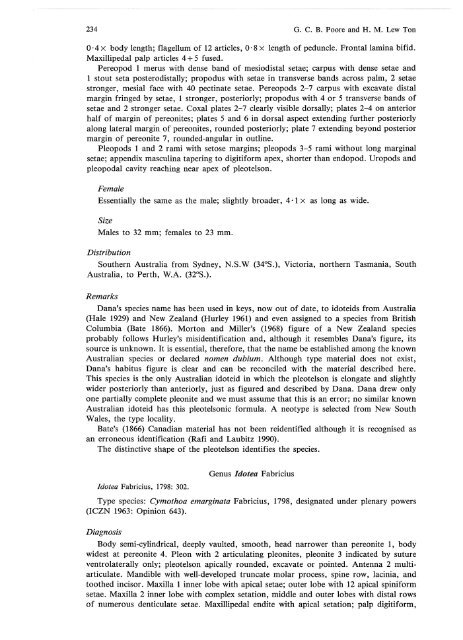Idoteidae of Australia and New Zealand (Crustacea: Isopoda: Valvif ...
Idoteidae of Australia and New Zealand (Crustacea: Isopoda: Valvif ...
Idoteidae of Australia and New Zealand (Crustacea: Isopoda: Valvif ...
You also want an ePaper? Increase the reach of your titles
YUMPU automatically turns print PDFs into web optimized ePapers that Google loves.
234 G. C. B. Poore <strong>and</strong> H. M. Lew Ton<br />
0-4 x body length; flagellum <strong>of</strong> 12 articles, 0-8 x length <strong>of</strong> peduncle. Frontal lamina bifid.<br />
Maxillipedal palp articles 4 + 5 fused.<br />
Pereopod 1 merus with dense b<strong>and</strong> <strong>of</strong> mesiodistal setae; carpus with dense setae <strong>and</strong><br />
1 stout seta posterodistally; propodus with setae in transverse b<strong>and</strong>s across palm, 2 setae<br />
stronger, mesial face with 40 pectinate setae. Pereopods 2-7 carpus with excavate distal<br />
margin fringed by setae, 1 stronger, posteriorly; propodus with 4 or 5 transverse b<strong>and</strong>s <strong>of</strong><br />
setae <strong>and</strong> 2 stronger setae. Coxal plates 2-7 clearly visible dorsally; plates 2-4 on anterior<br />
half <strong>of</strong> margin <strong>of</strong> pereonites; plates 5 <strong>and</strong> 6 in dorsal aspect extending further posteriorly<br />
along lateral margin <strong>of</strong> pereonites, rounded posteriorly; plate 7 extending beyond posterior<br />
margin <strong>of</strong> pereonite 7, rounded-angular in outline.<br />
Pleopods 1 <strong>and</strong> 2 rami with setose margins; pleopods 3-5 rami without long marginal<br />
setae; appendix masculina tapering to digitiform apex, shorter than endopod. Uropods <strong>and</strong><br />
pleopodal cavity reaching near apex <strong>of</strong> pleotelson.<br />
Female<br />
Essentially the same as the male; slightly broader, 4-1 x as long as wide.<br />
Size<br />
Males to 32 mm; females to 23 mm.<br />
Distribution<br />
Southern <strong>Australia</strong> from Sydney, N.S.W (34°S.), Victoria, northern Tasmania, South<br />
<strong>Australia</strong>, to Perth, W.A. (32°S.).<br />
Remarks<br />
Dana's species name has been used in keys, now out <strong>of</strong> date, to idoteids from <strong>Australia</strong><br />
(Hale 1929) <strong>and</strong> <strong>New</strong> Zeal<strong>and</strong> (Hurley 1961) <strong>and</strong> even assigned to a species from British<br />
Columbia (Bate 1866). Morton <strong>and</strong> Miller's (1968) figure <strong>of</strong> a <strong>New</strong> Zeal<strong>and</strong> species<br />
probably follows Hurley's misidentification <strong>and</strong>, although it resembles Dana's figure, its<br />
source is unknown. It is essential, therefore, that the name be established among the known<br />
<strong>Australia</strong>n species or declared nomen dubium. Although type material does not exist,<br />
Dana's habitus figure is clear <strong>and</strong> can be reconciled with the material described here.<br />
This species is the only <strong>Australia</strong>n idoteid in which the pleotelson is elongate <strong>and</strong> slightly<br />
wider posteriorly than anteriorly, just as figured <strong>and</strong> described by Dana. Dana drew only<br />
one partially complete pleonite <strong>and</strong> we must assume that this is an error; no similar known<br />
<strong>Australia</strong>n idoteid has this pleotelsonic formula. A neotype is selected from <strong>New</strong> South<br />
Wales, the type locality.<br />
Bate's (1866) Canadian material has not been reidentified although it is recognised as<br />
an erroneous identification (Rafi <strong>and</strong> Laubitz 1990).<br />
The distinctive shape <strong>of</strong> the pleotelson identifies the species.<br />
Idotea Fabricius, 1798: 302.<br />
Genus Idotea Fabricius<br />
Type species: Cymothoa emarginata Fabricius, 1798, designated under plenary powers<br />
(ICZN 1963: Opinion 643).<br />
Diagnosis<br />
Body semi-cylindrical, deeply vaulted, smooth, head narrower than pereonite 1, body<br />
widest at pereonite 4. Pleon with 2 articulating pleonites, pleonite 3 indicated by suture<br />
ventrolateral^ only; pleotelson apically rounded, excavate or pointed. Antenna 2 multiarticulate.<br />
M<strong>and</strong>ible with well-developed truncate molar process, spine row, lacinia, <strong>and</strong><br />
toothed incisor. Maxilla 1 inner lobe with apical setae; outer lobe with 12 apical spiniform<br />
setae. Maxilla 2 inner lobe with complex setation, middle <strong>and</strong> outer lobes with distal rows<br />
<strong>of</strong> numerous denticulate setae. Maxillipedal endite with apical setation; palp digitiform,
















